Enhanced Predictive Model for the Mechanical Response of Compression-Loaded Slender Structures
Abstract
:1. Introduction
2. Materials and Methods
2.1. Samples and Experiments
2.2. Explicit Solver
2.3. Geometrical Discretization Model
2.4. Constituent Material
2.5. Material Model
3. Results
3.1. Experiments
- A structure made with thicker sheets (+20%) better resists compressive loads: increments in the maximum load (from 24.4 to 27.8 kN, +12.2%) and related displacement are evident (from 6.5 to 10.1 mm, +35.6%).
- The initial structural response remains substantially unchanged, as closely linked to the material elasticity: the curves have a similar slope until the moment when conditions of plates’ instability/plasticity emerge.
3.2. Simulations vs. Experiments
3.3. Stress vs. Strain
4. Discussion
4.1. Preliminary Considerations
- The experimental curves exhibit a slight offset (<2 mm), making it challenging to accurately replicate them through simulation (indicated as ‘a’ in Figure 7). This offset is likely attributed to the existence of small gaps, misalignments, or non-planarity in the samples and clamping systems (e.g., Figure 13a,b). Although the gradual recovery of this offset slightly alters the curve’s slope, leading to a slightly lower value compared to the simulation, it seems to be a minor concern.
- In line with typical numerical investigations, the geometry in this study was simplified, disregarding the impact of sheet bends resulting from plastic deformation or welding (as depicted in Figure 13c). However, it is well established that these factors can considerably influence the system’s response to external loads. Such alterations arise not only from changes in the geometry [32,33], which encompass increased material thicknesses, but also from variations in the material properties [34].
- A peculiar discontinuity in the simulated trends also appears (at 15–17 kN, indicated as ‘b’ in Figure 7). This is attributed to the sudden transition of material characteristics from the elastic to the plastic regime, occurring in the initial steps of the calculation. While such a discontinuity in material behavior does exist, as seen in Figure 2a and Figure 3, its effect is magnified due to the rapid traversal of the entire elastic increase ramp within a few time steps. This issue should be mitigated with a higher number of time discretization points, as that allows for a finer resolution. However, in explicit analyses, it is uncommon to directly control the discretization time, as it is determined algorithmically based on factors such as stress propagation (linked to the sound speed in the material) and finite element size. Although the literature provides interesting insights (e.g., [35]), it was decided not to change these auto-setting parameters but to indirectly optimize them by refining the mesh instead.
- The simulation shows an expected increase in load slightly past the midpoint of the observed interval (‘c’ in Figure 7). This occurrence coincides with the moment when the folds encounter each other (as shown in Figure 4d and Figure 14), resulting in an apparent stiffening of the system. This behavior is likely attributed to an inaccurate interpretation of the contact conditions by the numerical model, which deserves to be investigated.
- The assumption of confining the system between two plates serves as an initial approximation, significantly simplifying the analysis. However, it is important to recognize that this assumption deviates from reality. As depicted in Figure 10e, the bottom surface, in particular, is prone to slippage. Therefore, it becomes essential to consider other boundary conditions, even if it compromises efficiency, in order to accurately capture the system’s behavior.
4.2. Material Data
- Despite aluminum being a very well-studied metal, some of its mechanical properties are quite variable considering the alloys on the market. Once the alloy family and the treatment have been fixed, aspects such as density (ρ), Poisson’s ratio (ν), modulus of elasticity (E), and tangential modulus (Et) remain substantially constant. For instance, their values, as reported in Table 2, are truly representative of AA 6082-T6. However, it is not the same for tensile strength (Rm), yield strength (Rp0.2) and elongations, which are expressed only as minimum values assured by standards.
- In the case of axial crushing, little changes in properties can have a strong influence. The ability to absorb energy, as well as to counteract an excessive force peak, is dependent on the yield strength, which identifies, essentially, when the stress/strain curve bends to enter the plastic regime. The plasticity permits absorbing great amounts of energy while also reducing the peaks of loads.
4.3. True vs. Engineering Stress/Strain
4.4. Exploring Modeling Assumptions
- The physical system (i.e., the bumper) is subjected to a quasistatic load during testing. In a quasi-static analysis, the application of loads is time-dependent but occurs at a slow pace (i.e., mm/s), allowing for the neglect of inertial effects. In other words, the specific timing and inertial forces associated with the loading process are considered irrelevant. The focus is primarily on the equilibrium state and the progressive response of the system under gradually applied loads. The simulation of these situations should be carried out through an implicit analysis, more suitable for stationary problems or with loads gradually applied over time, offering greater numerical stability. At the same time, the explicit analysis was here preferred since it can offer several advantages such as (a) the accuracy in considering non-linearities (contacts, large displacements, and large deformations); (b) the possibility of splitting, paralleling, and speeding up the calculation (especially on multiprocessor systems). Preliminary attempts at implicit analysis were also made (using Ansys Workbench) without being convincing.
- In a quasistatic simulation, as stated, its time duration (also called ‘end time’) is irrelevant since time should not exert any influence. However, an explicit analysis is specifically designed to capture the dynamic behavior of problems, making the application speed of loads relevant. Consequently, the selection of the simulation interval carries a certain level of significance. Matching it with the actual duration of the experimental test (175 s), even with a workstation equipped with 12 processors (i.e., Intel R, Xeon Gold 6240R, 2.4 GHz), the calculation times would span several weeks. Numerous attempts were made to strike a balance between calculation times and accuracy by scaling down the time duration to 10, 5, 1, and 0.1 s, resulting in corresponding calculation times of about 33, 11, 3, and 0.5 h, respectively.
- Modifying the end time has notable consequences for both the initial and final regions of the load versus displacement curve (Figure 16). As expected, extending the calculation period reduces the visibility of discontinuities in the trends. However, the impact is more pronounced on deformed shapes that exhibit less closure, with larger and more pronounced deformed surfaces as the end time increases. At the same time, as the end time increases, the explicit analysis seems to lose the ability to recognize the initial sharp peak, flattening the response curve against incorrect shapes and values. All of this highlights the opportunity to optimize such a parameter on a case-by-case basis.
- The conditions of application of loads and constraints deserve better attention due to the relevant (potential) impacts on the study. In the specific case, the lower base was fixed and the upper base with ‘bonded’ contact was here assumed; this was in line with several similar studies [22,41,42,43]. However, a ‘frictionless’ contact was also considered. As evident in Figure 17, despite minimal effect on the first part of the load/displacement response, a better correspondence emerges elsewhere (e.g., at 30–70 mm/mm).
5. Conclusions
Author Contributions
Funding
Data Availability Statement
Acknowledgments
Conflicts of Interest
References
- Gross, D.; Ehlers, W.; Wriggers, P.; Schröder, J.; Müller, R. Mechanics of Materials—Formulas and Problems; Springer: Berlin/Heidelberg, Germany, 2017. [Google Scholar]
- Lu, G.; Yu, T.X. Energy Absorption of Structures and Materials; Elsevier: Amsterdam, The Netherlands, 2003. [Google Scholar]
- Jones, R.M. Buckling of Bars, Plates, and Shells; Bull Ridge Corporation: Blacksburg, VA, USA, 2006. [Google Scholar]
- Budiansky, B. Theory of buckling and post-buckling behaviour of elastic structures. Adv. Appl. Mech. 1974, 14, 1–65. [Google Scholar]
- Allaire, G. Numerical Analysis and Optimization: An Introduction to Mathematical Modelling and Numerical Simulation; OUP Oxford: Oxford, UK, 2007. [Google Scholar]
- Abdullah, N.A.Z.; Sani, M.S.M.; Salwani, M.S.; Husain, N.A. A review on crashworthiness studies of crash box structure. Thin-Walled Struct. 2020, 153, 106795. [Google Scholar]
- Xu, F.; Zhang, X.; Zhang, H. A review on functionally graded structures and materials for energy absorption. Eng. Struct. 2018, 171, 309–325. [Google Scholar]
- Sharpe, N.; Vendrig, R.; Houtzager, K. Improved design for frontal protection. SAE Tech. Pap. 2001, 6, 137. [Google Scholar]
- Pavlovic, A.; Fragassa, C.; Minak, G. Buckling Analysis of Telescopic Boom: Theoretical and Numerical Verification of Sliding Pads. Teh. Vjesn. 2017, 24, 729–735. [Google Scholar]
- Fragassa, C.; Minak, G.; Pavlovic, A. Measuring Deformations in a Telescopic Boom under Static and Dynamic Load Conditions. Facta Univ. Ser. Mech. Eng. 2020, 18, 315–328. [Google Scholar] [CrossRef]
- Baumgardt, G.R.; Fragassa, C.; dos Santos, E.D.; Rocha, L.A.O.; da Silveira, T.; Isoldi, L.A. Computational model verification and validation for the numerical analysis of elasto-plastic buckling due to combined loads of thin steel plates. Metals 2023, 13, 731. [Google Scholar] [CrossRef]
- Othman, A.; Fikri, M.; Jailani, A.; Ahmad, M.N. Finite Element Simulation of Off-Axis Crushing Performance of Polyurethane Foam Aluminium Alloy Tubes. In Proceedings of the 3rd International Conference on Engineering and ICT (iCEi2012), Melaka, Malaysia, 4–6 April 2012. [Google Scholar]
- Othman, A.; Iailani, A. Off-axis crushes simulation of thin-walled tapered tubes inserted with foam-filled structures. APCBEE Procedia 2014, 9, 395–400. [Google Scholar] [CrossRef]
- Kotelko, M.; Ferdynus, M.; Jankowski, J. Energy absorbing effectiveness–different approaches. Acta Mech. Autom. 2018, 12, 54–59. [Google Scholar]
- Muhammad, N.S.; Hambali, A.; Rosidah, J.; Widodo, W.S.; Ahmad, M.N. A review of energy absorption of automotive bumper beam. Int. J. Appl. Eng. Res. 2017, 12, 238–245. [Google Scholar]
- Su, J.; Lou, J.; Jiang, X. Optimized design of aluminium bumper by impact test and computer simulation analysis. J. Phys. Conf. Ser. 2021, 1952, 032067. [Google Scholar] [CrossRef]
- Hosseinzadeh, R.; Shokrieh, M.M.; Lessard, L.B. Parametric Study of Automotive Composite Bumper Beams Subjected to Low-Velocity Impacts. Compos. Struct. 2005, 68, 419–427. [Google Scholar] [CrossRef]
- Zahran, M.S.; Xue, P.; Esa, M.S.; Abdelwahab, M.M. A novel tailor-made technique for enhancing the crashworthiness by multi-stage tubular square tubes. Thin-Walled Struct. 2018, 122, 64–82. [Google Scholar]
- Jadhav, S.; Pawar, A.R. Investigate optimum shape of crash box analysis experimentally and numerically on geometry aspect. J. Anal. Comput. 2020, 16, 8. [Google Scholar]
- Shaikh, A.S.; Borkar, B.R.; Shinde, V.B. Vehicle crash box analysis of different shapes subjected to impact loading for minimum deflection using ANSYS. In Proceedings of the 2nd International Conference on Manufacturing Excellence (ICMAX-2019), Nashik, India, 15–16 February 2019. [Google Scholar]
- Du, B.; Li, Q.; Zheng, C.; Wang, S.; Gao, C.; Chen, L. Application of lightweight structure in automobile bumper beam: A review. Materials 2023, 16, 967. [Google Scholar] [CrossRef]
- Abdullah, N.A.Z.; Sani, M.S.M.; Salwani, M.S. Study of modal properties and crashworthiness performance of crash box numerical model with different joining modelling strategies. IOP Conf. Ser. Mater. Sci. Eng. 2021, 1062, 012008. [Google Scholar]
- Belytschko, T.; Ong, J.S.J.; Liu, W.K.; Kennedy, J.M. Hourglass control in linear and nonlinear problems. Comput. Methods Appl. Mech. Eng. 1984, 43, 251–276. [Google Scholar] [CrossRef] [Green Version]
- CEN EN573-3:2007; Aluminium and Aluminium Alloys—Chemical Composition and Form of Wrought Products—Part 3: Chemical Composition and Form of Products. European Committee for Standardization: Bruxelles, Belgium.
- CEN EN 755-2:2016; Aluminium and Aluminium Alloys—Extruded Rod/Bar, Tube and Profiles—Part 2: Mechanical Properties. European Committee for Standardization: Bruxelles, Belgium.
- CEN EN 485-2:2016; Aluminium and Aluminium Alloys—Sheet, Strip and Plate—Part 2: Mechanical Properties. European Committee for Standardization: Bruxelles, Belgium.
- Günzel, J.; Hauß, J.; Groche, P. Opportunities, challenges and influencing factors in the forming of preconditioned semi-finished products made of EN AW-6082 and-7075. Adv. Eng. Mater. 2023, 2201799. [Google Scholar] [CrossRef]
- Wang, T.; Hopperstad, O.S.; Lademo, O.G.; Larsen, P.K. Finite element analysis of welded beam-to-column joints in aluminium alloy EN AW 6082 T6. Finite Elem. Anal. Des. 2007, 44, 1–16. [Google Scholar] [CrossRef]
- Benson, S.; Downes, J.; Dow, R.S. Ultimate strength characteristics of aluminium plates for high-speed vessels. Ships Offshore Struct. 2011, 6, 67–80. [Google Scholar] [CrossRef]
- El-Rayes, M.M.; El-Danaf, E.A. The influence of multi-pass friction stir processing on the microstructural and mechanical properties of Aluminum Alloy 6082. J. Mater. Process. Technol. 2012, 212, 1157–1168. [Google Scholar] [CrossRef]
- Yibo, P.; Gang, W.; Tianxing, Z.; Shangfeng, P.; Yiming, R. Dynamic mechanical behaviors of 6082-T6 aluminum alloy. Adv. Mech. Eng. 2013, 5, 878016. [Google Scholar] [CrossRef] [Green Version]
- Kim, J.K.; Thomson, P.F. Forming behaviour of sheet steel laminate. J. Mater. Process. Technol. 1990, 22, 45–64. [Google Scholar] [CrossRef]
- Tsai, C.L.; Park, S.C.; Cheng, W.T. Welding distortion of a thin-plate panel structure. Weld. J. 1999, 78, 156-s. [Google Scholar]
- Leggatt, R.H. Residual stresses in welded structures. Int. J. Press. Vessel. Pip. 2008, 85, 144–151. [Google Scholar] [CrossRef]
- Kim, W.; Reddy, J.N. A comparative study of implicit and explicit composite time integration schemes. Int. J. Struct. Stab. Dyn. 2020, 20, 2041003. [Google Scholar] [CrossRef]
- Rui, Y.; Subic, A.; Takla, M.; Wang, C.H.; Niehoff, A.; Hamann, N.; Brueggemann, G.P. Biomimetic design of lightweight vehicle structures based on animal bone properties. Adv. Mater. Res. 2013, 633, 3–14. [Google Scholar] [CrossRef]
- Christy, T.V.; Murugan, N.; Kumar, S. A comparative study on the microstructures and mechanical properties of Al 6061 alloy and the MMC Al 6061/TiB2/12p. J. Miner. Mater. Charact. Eng. 2010, 9, 57–65. [Google Scholar]
- Sabry, I.; Ghafaar, M.A.; Mourad, A.H.I.; Idrisi, A.H. Stir casted SiC-Gr/Al6061 hybrid composite tribological and mechanical properties. SN Appl. Sci. 2020, 2, 943. [Google Scholar] [CrossRef] [Green Version]
- Teferi, F.T.; Kolhe, K.P.; Tsegaw, A.A.; Borena, T.G.; Avvari, M. The Advancement of Aluminium Metal Matrix Composite Reinforced with Silicon Carbide Particles (Al-6061/SiC p): A Review. In Advances of Science and Technology, Proceedings of the 9th EAI International Conference, ICAST 2021, Hybrid Event, Bahir Dar, Ethiopia, 27–29 August 2021; Proceedings, Part II; Springer International Publishing: Berlin/Heidelberg, Germany, 2021; pp. 326–336. [Google Scholar]
- NIST National Institute of Standards and Technology. 6061 Aluminium Alloys: Mechanical Properties. Available online: https://materialsdata.nist.gov/handle/11256/422 (accessed on 15 September 2022).
- Hussain, N.N.; Regalla, S.P.; Rao, Y.V.D. Comparative study of trigger configuration for enhancement of crashworthiness of automobile crash box subjected to axial impact loading. Procedia Eng. 2017, 173, 1390–1398. [Google Scholar] [CrossRef]
- Zarei, H.R.; Kröger, M. Crashworthiness optimization of empty and filled aluminum crash boxes. Int. J. Crashworthiness 2007, 12, 255–264. [Google Scholar] [CrossRef]
- Davoudi, M.; Kim, K. Energy Absorption Capability of Thin-Walled Structures with Various Cross Sections under Oblique Crash. Int. J. Steel Struct. 2022, 22, 1786–1797. [Google Scholar] [CrossRef]
- Pavlovic, A.; Fragassa, C. Investigating the crash-box-structure’s ability to absorb energy. Int. J. Crashworthiness, 2023; accepted. [Google Scholar]


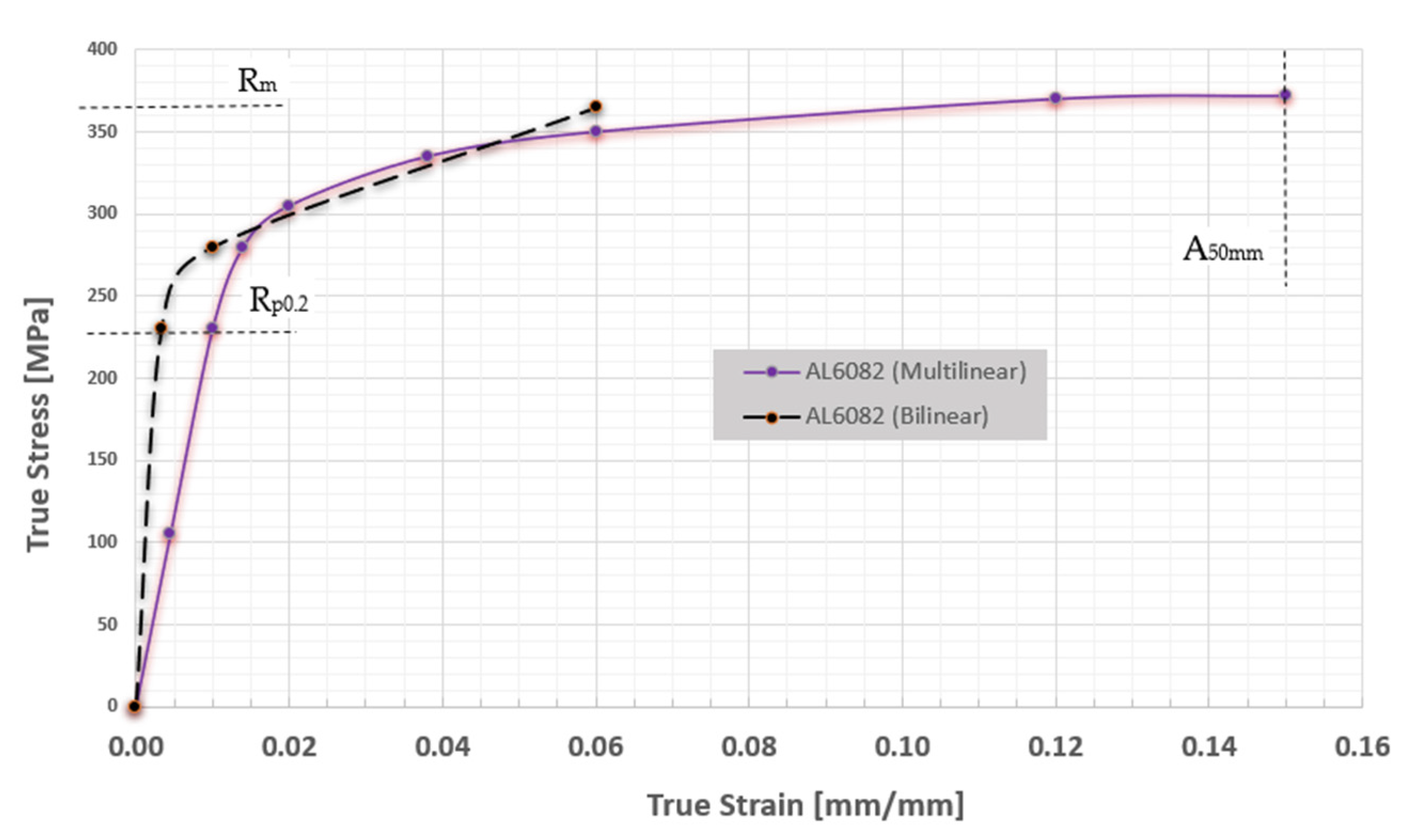
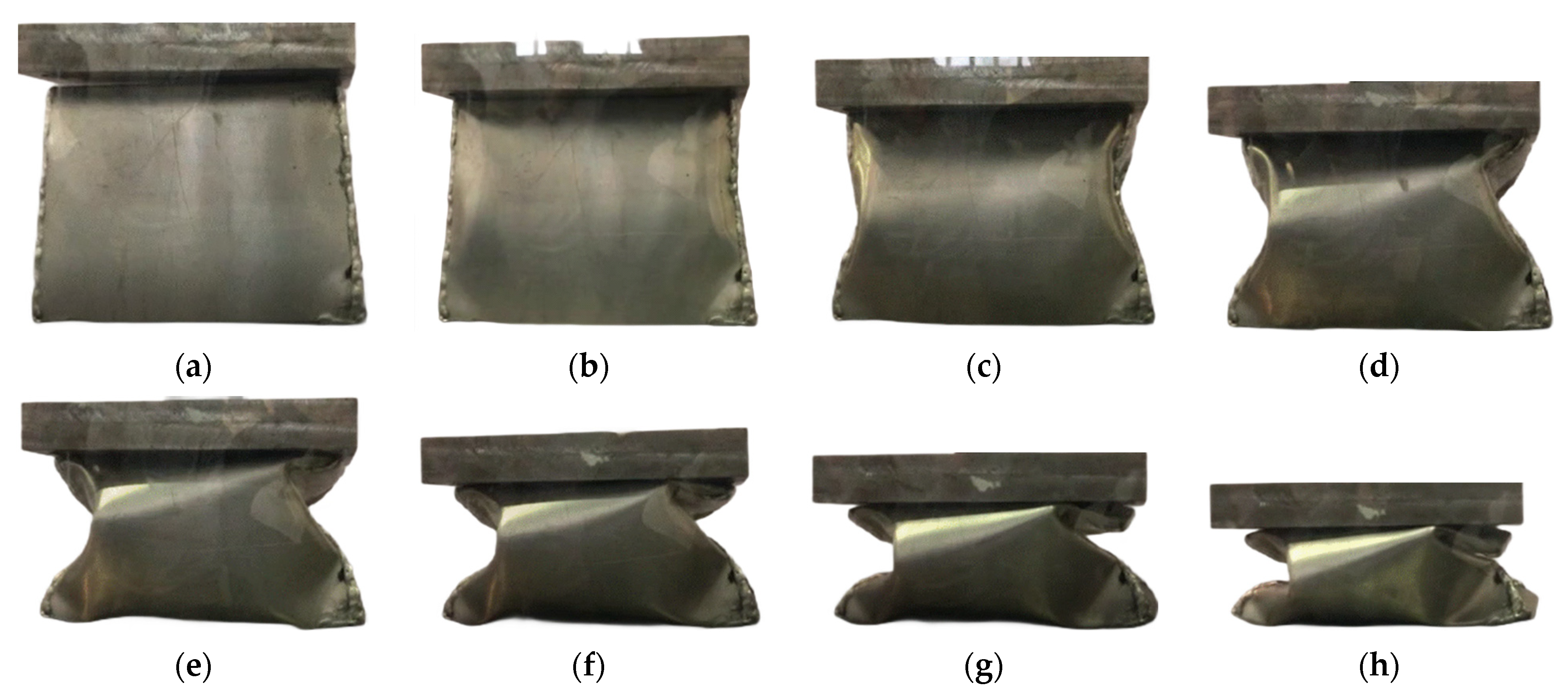

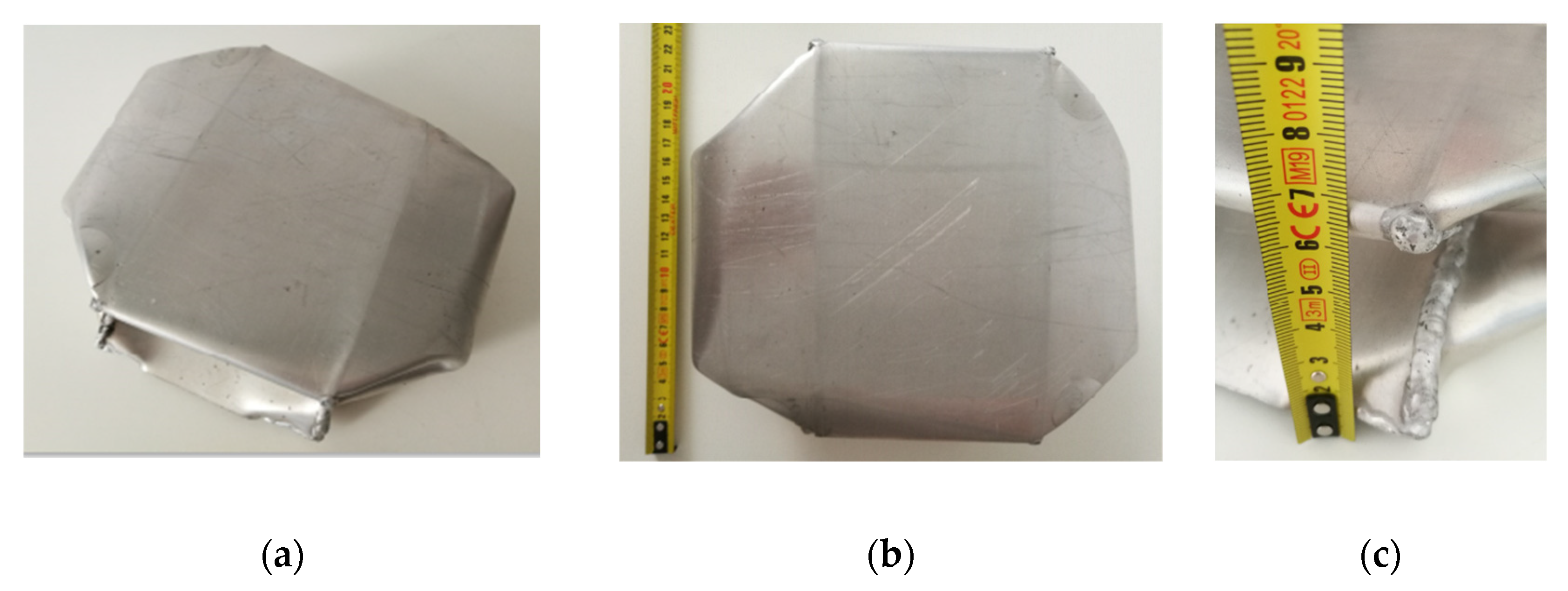
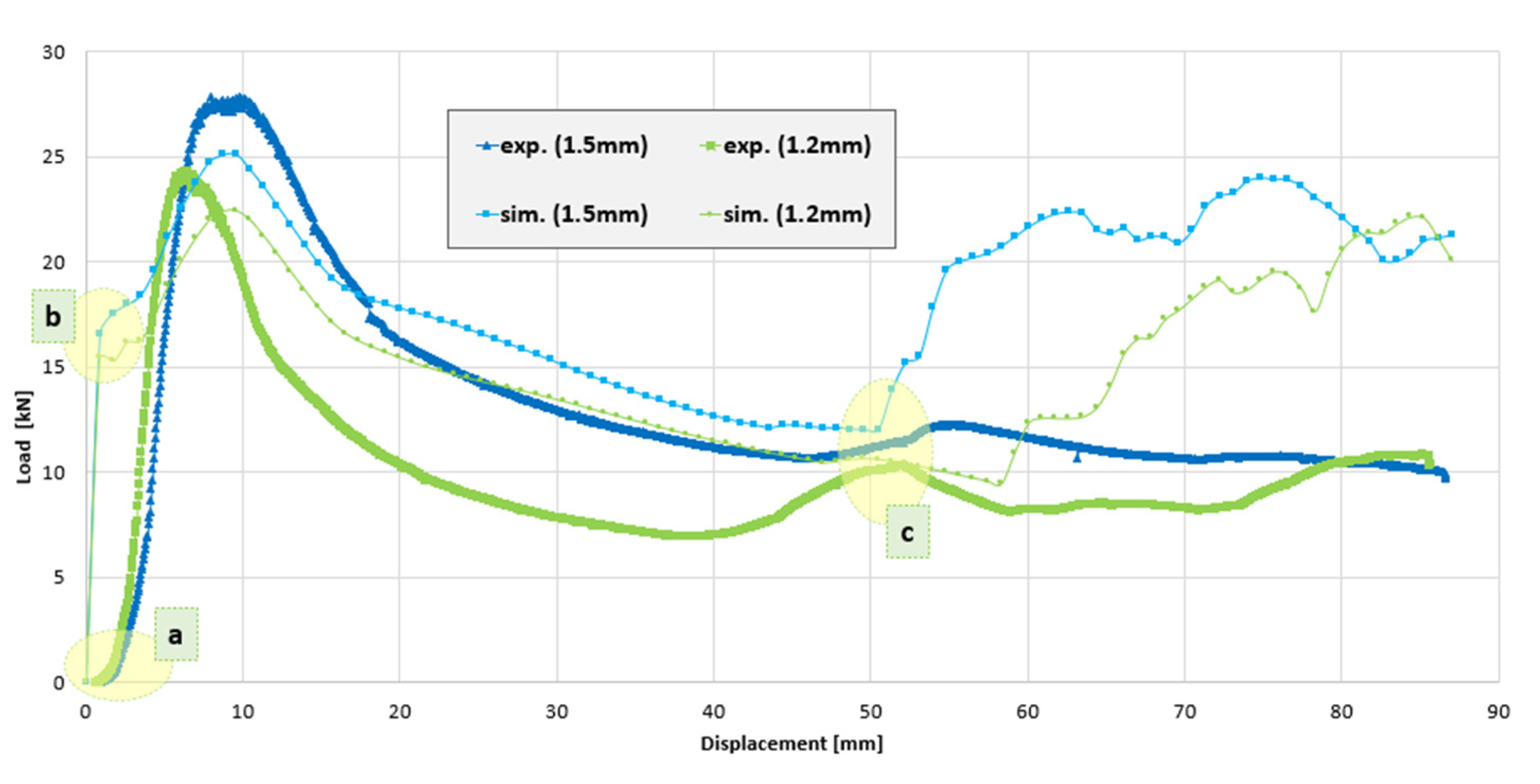



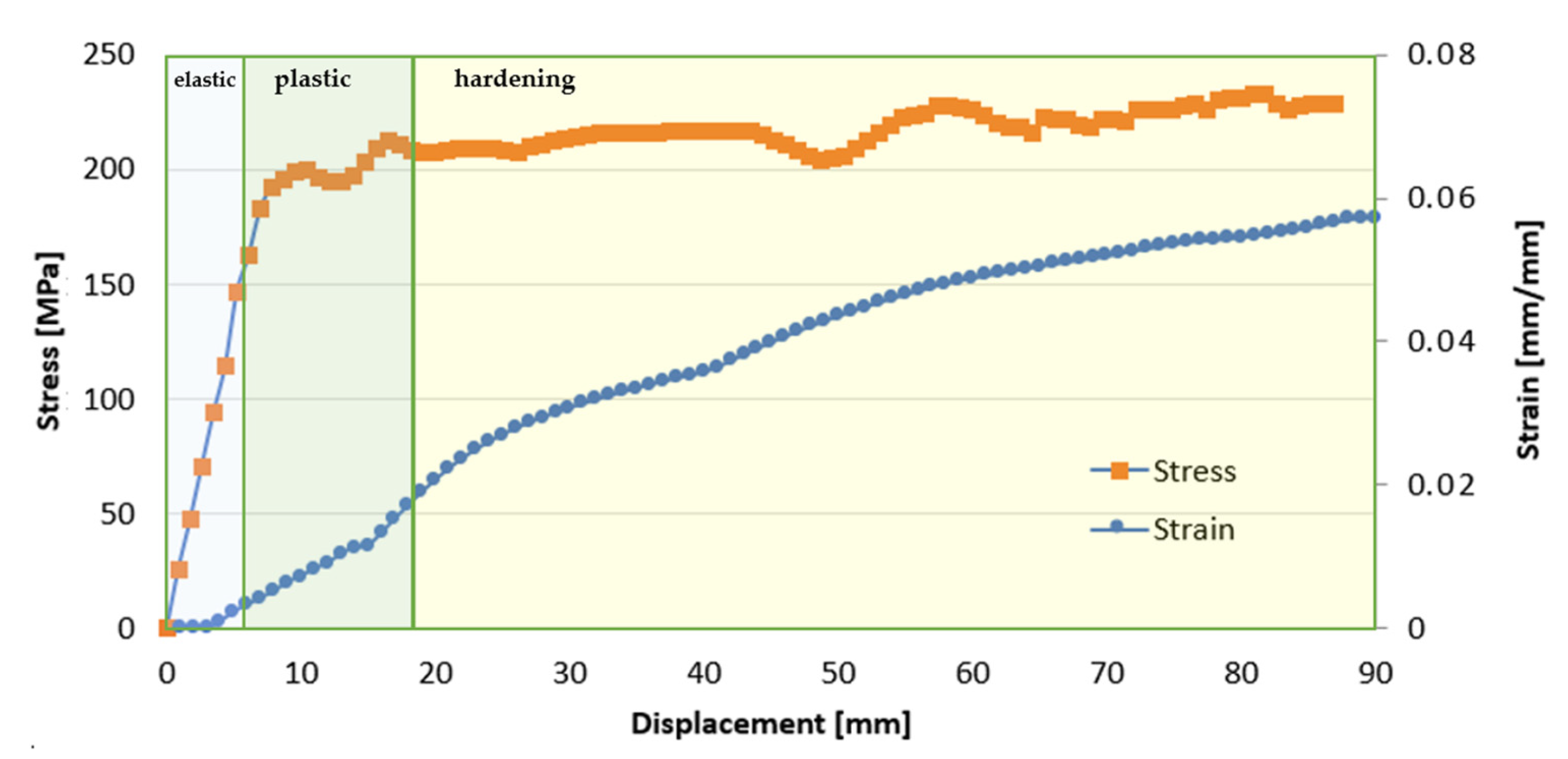


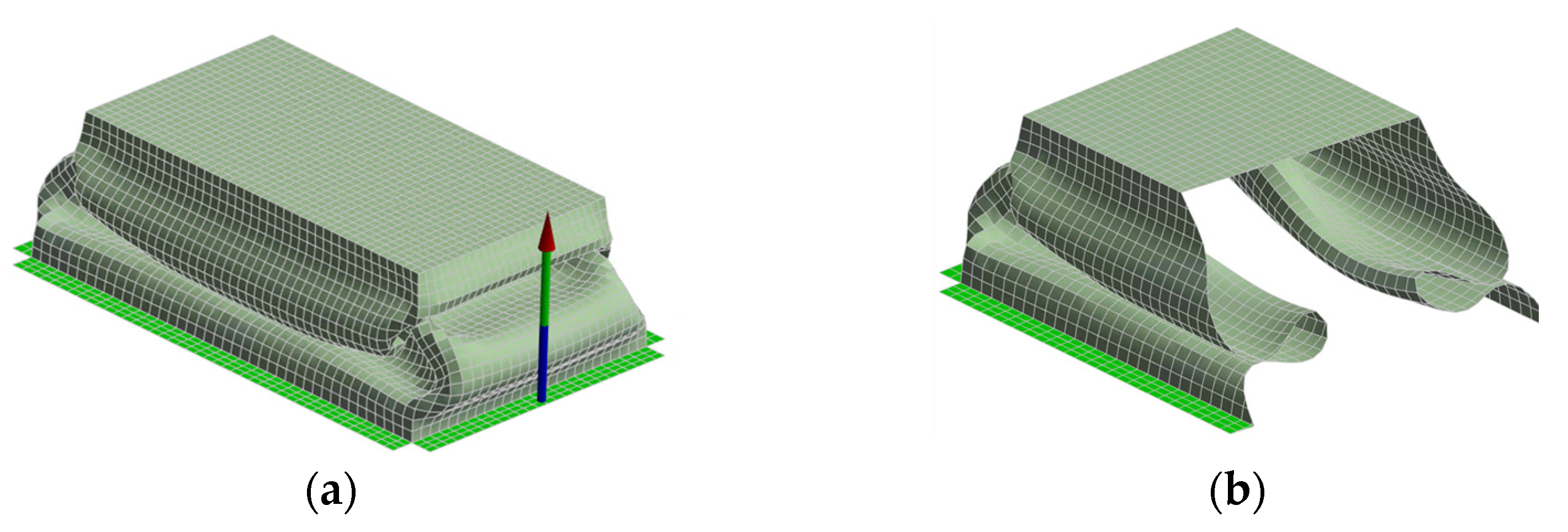



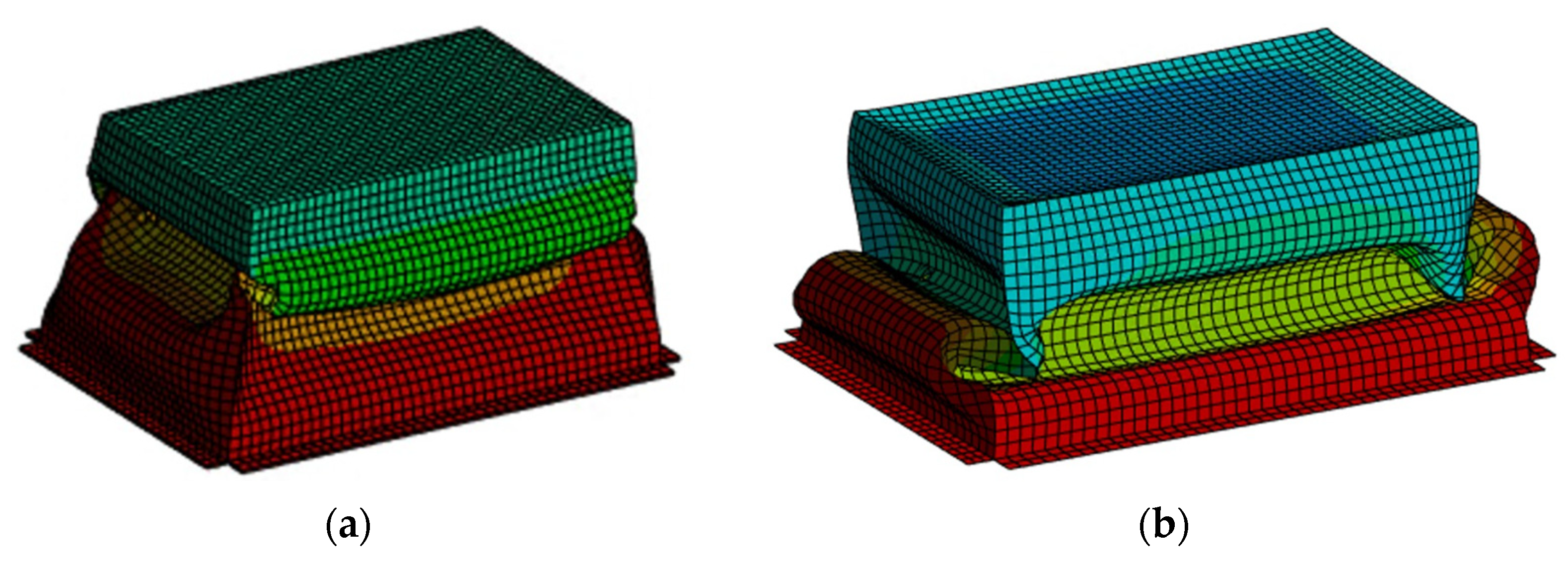
| Si | Fe | Cu | Mn | Mg | Cr | Zn | Ti | Others | Al |
|---|---|---|---|---|---|---|---|---|---|
| 0.70–1.30 | 0.50 max | 0.10 max | 0.40–1.00 | 0.60–1.20 | 0.25 max | 0.20 max | 0.10 max | 0.05 tot | balanced |
| Characteristics | Unit | EN755-2 | EN485-2 | Used | |
|---|---|---|---|---|---|
| Density | ρ | km/m3 | 2700 | 2700 | 2700 |
| Poisson’s ratio | ν | --- | 0.33 | 0.33 | 0.33 |
| Modulus of elasticity | E | Mpa | 69,000 | 69,000 | 69,000 |
| Tangential modulus | Et | Mpa | 26,000 | 26,000 | 26,000 |
| Tensile strength (min) | Rm | Mpa | 270 | 310 | 360 |
| Yield strength (min) | Rp0.2 | Mpa | 230 | 260 | 230 |
| Elongation at break (min) | A50mm | % | 6 | 6 | 15 |
| Thickness | Parameter | Offset | Max | b | c | d | e | f | g | h | Residual | |
|---|---|---|---|---|---|---|---|---|---|---|---|---|
| 1.5 mm | Displacement | mm | 1.2 | 8.6 | 12.5 | 25.0 | 37.5 | 50.0 | 62.5 | 75.0 | 87.5 | 7.0 |
| Load | kN | 1.6 | 27.6 | 24.9 | 14.3 | 11.5 | 11.2 | 11.3 | 10.8 | 9.9 | 0.0 | |
| 1.2 mm | Displacement | mm | 1.6 | 6.4 | 12.5 | 25.0 | 37.5 | 50.0 | 62.5 | 75.0 | 87.5 | 6.6 |
| Load | kN | 0.9 | 24.1 | 14.8 | 8.8 | 7.0 | 10.1 | 8.3 | 8.9 | 10.4 | 0.0 | |
Disclaimer/Publisher’s Note: The statements, opinions and data contained in all publications are solely those of the individual author(s) and contributor(s) and not of MDPI and/or the editor(s). MDPI and/or the editor(s) disclaim responsibility for any injury to people or property resulting from any ideas, methods, instructions or products referred to in the content. |
© 2023 by the authors. Licensee MDPI, Basel, Switzerland. This article is an open access article distributed under the terms and conditions of the Creative Commons Attribution (CC BY) license (https://creativecommons.org/licenses/by/4.0/).
Share and Cite
Fragassa, C.; Pavlovic, A. Enhanced Predictive Model for the Mechanical Response of Compression-Loaded Slender Structures. Metals 2023, 13, 1286. https://doi.org/10.3390/met13071286
Fragassa C, Pavlovic A. Enhanced Predictive Model for the Mechanical Response of Compression-Loaded Slender Structures. Metals. 2023; 13(7):1286. https://doi.org/10.3390/met13071286
Chicago/Turabian StyleFragassa, Cristiano, and Ana Pavlovic. 2023. "Enhanced Predictive Model for the Mechanical Response of Compression-Loaded Slender Structures" Metals 13, no. 7: 1286. https://doi.org/10.3390/met13071286






